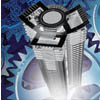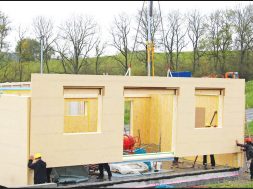Building with Automation

This article will give in-depth analysis on the building automation industry in India and how the technology create its own way to growth.
Opportunities for building automation
The building automation market in India is witnessing an exponential growth for the past few years and the sector will grow further with government’s new initiatives.
“Due to modernisation of government offices and 100- smart cities plan, the building automation market in India is expected to experience a robust growth, especially in hospitality industry and green building infrastructure,” says Kanny Leong, Co-founder and Executive Director, Crestron Asia.
Speaking on the opportunities for the building automation in India Leong says that, an efficient building automation system can ensure a centralised intelligent energy management system, integrated HVAC system, lighting control system, connected networks of hardware and software, which allow users to monitor and control the facilities across the building. “Such increasing demand for smart homes and buildings with well-integrated and applied technologies shows a very bright future for companies like Crestron who can operate across the entire building automation value chain,” states Leong.
“Not only smart homes, we see very potential growth in buildings inside a campus or healthcare centre. These areas may also incorporate building automation technologies to reduce their operating cost and to maximise productivity,“ adds Leong.
Farook Merchant, Chairman and Managing Director, Messung Group, has a different outlook on building automation in India. He suggests that making people aware about IBMS is very important. He notes that the sector is still young and there is need to make people aware about IBMS. “Building automation sector in India is at its nascent stage and there is huge potential for Integrated Building Management Systems (IBMS). To begin with there is an immediate need to educate stakeholders like building owner, facility manager, occupant, system integrator and consulting specifying engineer about the relevance and advantages of implementing BMS, specifically IBMS,” he points out.
Indian consumer wants value for money and efficient IBMS can save cost by providing return on investment within shorter period of time along with ease of maintenance, increased life span of building and sustainable health. Green buildings and energy management will be the key areas of opportunity for building automation sector in India.
Further, the government’s initiative for smart and sustainable cities, modernisation of government offices, growth in IT/ITeS sector and demand for commercial complex will drive the future growth of building automation in India.
Latest trends
As India moves towards achieving its 100 -Smart City goal, use of technologies to achieve green, safe and productive environment are means to evaluate the smartness of building. Some surveys found that, in general, safety and productivity scores of buildings on average are very low, addressing the potential risks and sustainability problems of buildings. Speaking on the trends in the building automation solutions, Leong suggests, “We believe that building automation solutions in future should pay more attention in safety and security development, such as incorporating real-time surveillance tracking devices into BMS, as well as to improve building productivity in terms of indoor environment comfort, ease of control and wireless connectivity to cope with the increase usage of wireless technologies within a building.”
The rapid strides in technology has brought to the living and working environment, smart technologies of less-costly, more accessible cloud-based services would take off in a big way. It is expected that those automated devices are able to communicate in a seamless manner, enables users to control and monitor all connected devices at anytime and anywhere.
There has been tremendous amount of advancement in the technology used for building automation. Merchant observes two major aspects in terms of latest trends in building automation sector. He notes, “Implementation of IoT in building automation and control system for remotely controlling and troubleshooting multiple buildings from central hub. This can be achieved by using Niagara framework which is an open platform and supports direct communication with multiple protocols including, BACnet, KNX, LONwork etc., to the IP layer. Increased adoption of wireless building automation and control systems for convenience and retrofitting is also a new upcoming technology in the market.”
Offering for commercial and IT/ITeS sectors
Players in the building automation sector such as Messung and Creston shares information about the solutions they provide for commercial and IT/ITeS sector. Crestron delivers complete building management for maximum energy and operational efficiency. The Crestron Fusion enterprise management software is the smart way to integrate disparate systems throughout an enterprise even a building. Network all of multimedia, environmental, and room-scheduling technology using existing IT infrastructure, and Crestron Fusion will let user monitor, manage, and control systems across the entire enterprise with ease. “Save time and money while maximising resources with the most advanced enterprise solution available,” says Leong.
Additionally, its centralised environmental controls and record-keeping provide a powerful real-time and historical overview of operations. See exactly what changes affect energy consumption with useful data analysis tools, and then maximise energy efficiency by selectively controlling lighting, HVAC, and other equipment remotely.
“Crestron also provides an open, IP-based architecture for integrating all of existing building’s systems on one platform, connects all systems and devices to our control system on the managed network,” says Leong. Crestron control systems feature native SNMP support for enterprise level IT management software suites and BACnet/IP support for integration of HVAC and BMS systems. All systems run independently and communicate with each other, creating a truly smart building.
“Our focus is to offer holistic IBMS solutions to all the target sectors. Specifically speaking about commercial and IT/ITeS sectors we will offer HVAC, lighting, security and access and energy management, with an objective to minimise operational cost in the long run by offering energy efficient solutions coupled with remote maintenance,” briefs Merchant.
Minimising operational cost
There are various aspects through which operational cost can be minimised. In any given building scenario the major component of the cost comprise of HVAC (Heating, Ventilation and Air Conditioning) and lighting. Most of the times the power utilisation for HVAC and lighting is 60 per cent to 90 per cent of the total consumption.
Merchant finds that use of IBMS solutions can minimise the operational cost, on this note he states, “With implementation of robust IBMS solutions one can monitor, analyse and ensure appropriate utilisation of available resources. It also helps to take immediate corrective measures to avoid any wastage of resources and manage available energy in most efficient manner. IBMS empowers to take right decision at the right time in terms of the exact requirements of the building to run efficiently resulting into minimising the operational cost in the long run.”
On the other hand one can also save on uncalled investments by preventing breakdown of capital equipment with implementation of appropriate IBMS, anticipating component and product failure at early stage.
Many researches show that significant electrical energy waste results from lighting, AV and IT equipment left on when not in use. “Crestron provides the reporting and monitoring tools to dramatically limit this waste and proactively reduce the cost of operations,” states Leong.
Crestron Fusion RV software enables users to centrally monitor, manage and maintain AV resources in every room. User can track equipment usage to schedule pre-emptive routine maintenance, provide real-time remote technical support when issues arise and receive instant alert notifications on mobile device hence minimising equipment downtime and reducing operation costs. Built-in room scheduling empowers end-users to schedule meetings and book rooms. Robust repo rting features in Crestron Fusion RV provide data for effective AV purchasing decisions, as well as maximise room usage and availability.
Occupancy sensor and daylight sensor deliver a powerful and cost-effective solution for reducing energy costs and enhancing the functionality of lighting and environmental systems. Even better, all these equipment can be integrated to Crestron control system and Fusion management platform, achieve more efficient building operations at reduced energy and labour costs while providing a safe and quality working environment to the occupants.
Building automation industry in India
India is expected to emerge as the world’s third largest construction market by 2020, by adding 11.5 mn homes every year. And apart from residential, the building automation technologies in some non-residential segments are still under-developed. Some commercial and community facilities are indeed looking for up-to-standard integrated and applied technologies to realise the much talked concept of “Smart Cities”. Sharing the views on building automation industry in India, Leong says, “Education and healthcare segments are where we foresee a strong boom. We believe that the building automation industry, particularly in green practices will continue to grow at a fast pace on the back of rising demand for energy-efficient solutions from a wide spectrum of sectors, and consistent pressures to reduce operational costs. The increasing importance placed by organisations across the globe as well as Indian government would become the key challenge, yet an opportunity to the industry players.”
Building automation industry in India is at its nascent stage and requires awareness among developers and building owners about IBMS systems. “The building automation industry is divided into MNCs and small domestic players. MNCs like Honeywell, Schneider and Siemens for whom IBMS is one of the business verticals along with various other verticals for supplying components and hardware for HVAC, lighting, security and access control, fire, sensors and energy management. The domestic players consists of small companies providing standalone products and solutions that are cost effective but often not reliable and do not offer an integrated platform for combining entire building services,” explains Merchant.
Further he adds, “Our market reading highlights that IT/ITeS and hospitality sector is the largest adaptor of IBMS technology while malls and hospitals should focus on maintenance with a long-term approach.”
Conclusion
The compound annual growth rate of building automation and control systems in India is projected at more than 22 per cent during 2015-2020. With the development for the smart cities and urbanisation there is lot of room for building automation industry to grow. With latest technologies and solutions that will help users to monitor and control facilities across the building and also be able to take and advantage of minimised operations cost
12
Cookie Consent
We use cookies to personalize your experience. By continuing to visit this website you agree to our Terms & Conditions, Privacy Policy and Cookie Policy.









